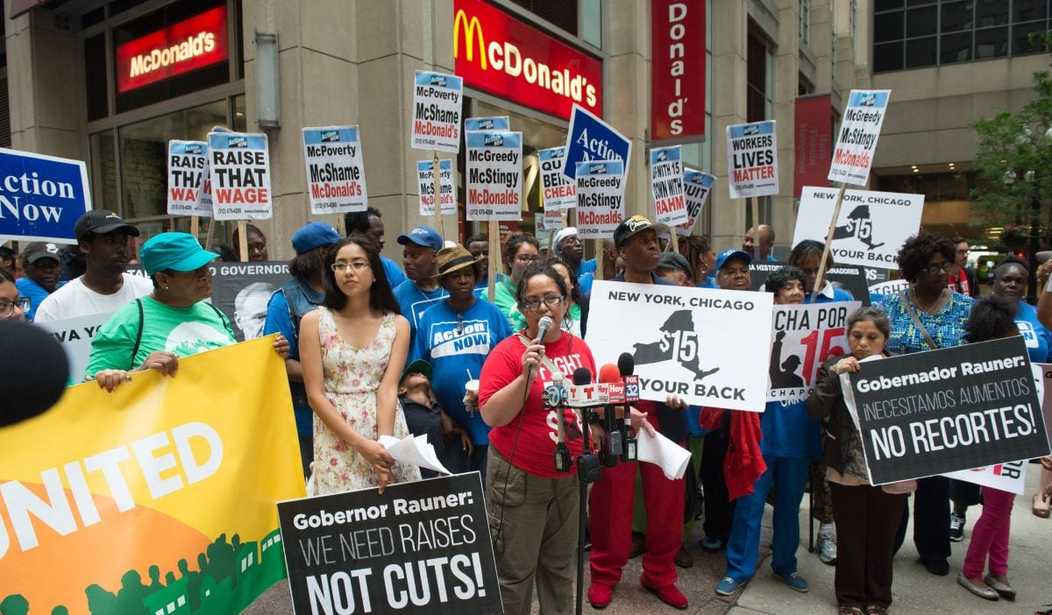The drive to impose a $15 an hour minimum wage on businesses large and small is making fine progress.
Except, the progress is toward numerous industries rushing to automate to avoid ruination.
Of course, this isn’t a surprise to anyone, except perhaps to those poor kids who believe in magic. The fairy tale being told by organized labor — that no one will lose their jobs if the minimum wage is nearly doubled — has been swallowed whole by those ignorant of basic economics.
The latest company to turn to automation is McDonald’s. The burger giant is installing self-serve kiosks at locations across the country – surely only the beginning of massive changes to its workforce.
It’s not just McDonald’s that has embraced job-replacing technology. Numerous restaurant chains (both quick service and full service) have looked to computer tablets as a solution for rising labor costs that won’t adversely impact the customer’s experience. Eatsa, a fully-automated restaurant concept, now has five locations—all in cities or states that have embraced a $15 minimum wage. And in a scene stolen from The Jetsons, the Starship delivery robot is now navigating the streets of San Francisco with groceries and other consumer goods. The company’s founder pointed to a rising minimum wage as a key factor driving the growth of his automated delivery business.
Of course, not all businesses have the capital necessary to shift from full-service to self-service. And that brings me to my next correct prediction–that a $15 minimum wage would force many small businesses to lay off staff, seek less-costly locations, or close altogether.
Tragically, these stories—in California in particular–are too numerous to cite in detail here. They include a bookstore in Roseville, a pub in Fresno, restaurants and bakeries in San Francisco, a coffee shop in Berkeley, grocery stores in Oakland, a grill in Santa Clara, and apparel manufacturers through the state. In September of this year, nearly one-quarter of restaurant closures in the Bay Area cited labor costs as one of the reasons for shutting down operations. And just this past week, a California-based communications firm announced it was moving 75 call center jobs from San Diego to El Paso, Texas, citing California’s rising minimum as the “deciding factor.” (Dozens of additional stories can be found at the website FacesOf15.com.)
Other states are also learning the same basic economic lesson: Customers have a limit to what they will pay for service. Voters in Washington, Colorado, Maine and Arizona voted to raise minimum wages on Election Day, convinced of the policy’s merits after millions of dollars were spent by union advocates. In the immediate aftermath, family-owned restaurants, coffee shops and even childcare providers have struggled to absorb the coming cost increase—with parents paying the cost through steeper childcare bills, and employees paying the cost through reduced shift hours or none at all.
Fast food companies depend on repeat customers — people and families that buy products 4 or 5 times a month. How many of those families will continue to visit that many times when a Big Mac is 40% more expensive?
Labor accounts for a quarter to a third of the average fast-food restaurant’s costs. Currently, wages in the fast-food industry run around $9 an hour. Going to $15 an hour means increasing pay by over 50 percent. Prices would have to rise by at least one-sixth (50 percent multiplied by one third) to cover the base-wage increases. Of course, those price increases would drive some customers away, so restaurants would need to raise prices again. But as a baseline, prices would have to rise by at least one-sixth.
As businesses and people vote with their feet and move out of cities that are forcing economic catastrophe on businesses, city neighborhoods will be hollowed out. And the backbone of any city’s economy — small businesses — will begin to disappear, with negative effects on the quality of life and employment opportunities.










Join the conversation as a VIP Member